
Currier & Ives Illustrations - Page 1
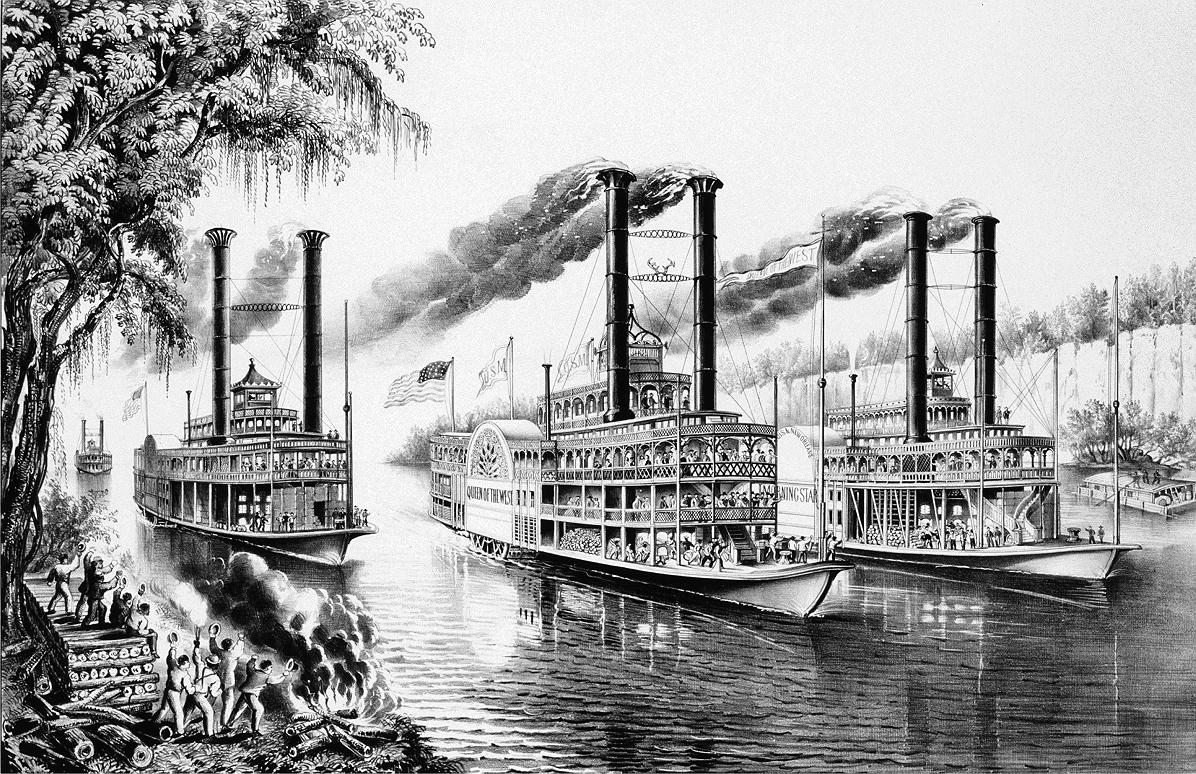
From the Library of Congress Prints & Photographs Online Catalog at loc.gov
It appears that Fanny Palmer worked in a medium that resembles a charcoal pencil. The drawing is very interesting to look at in high resolution with Palmer's subtle line technique which produced a variety of rich textures. Currier & Ives also issued a color version of this image (BELOW), which was hand-painted, probably limited editions that were purchase by folks who framed and hung them on the walls at home and/or office.
Champions of the Mississippi: "A race for the Buckhorns" (The Queen of the West at center and the Morning Star on the right)
Fanny Palmer (1812-1876) artist
Lithograph published by Currier & Ives, circa 1866.
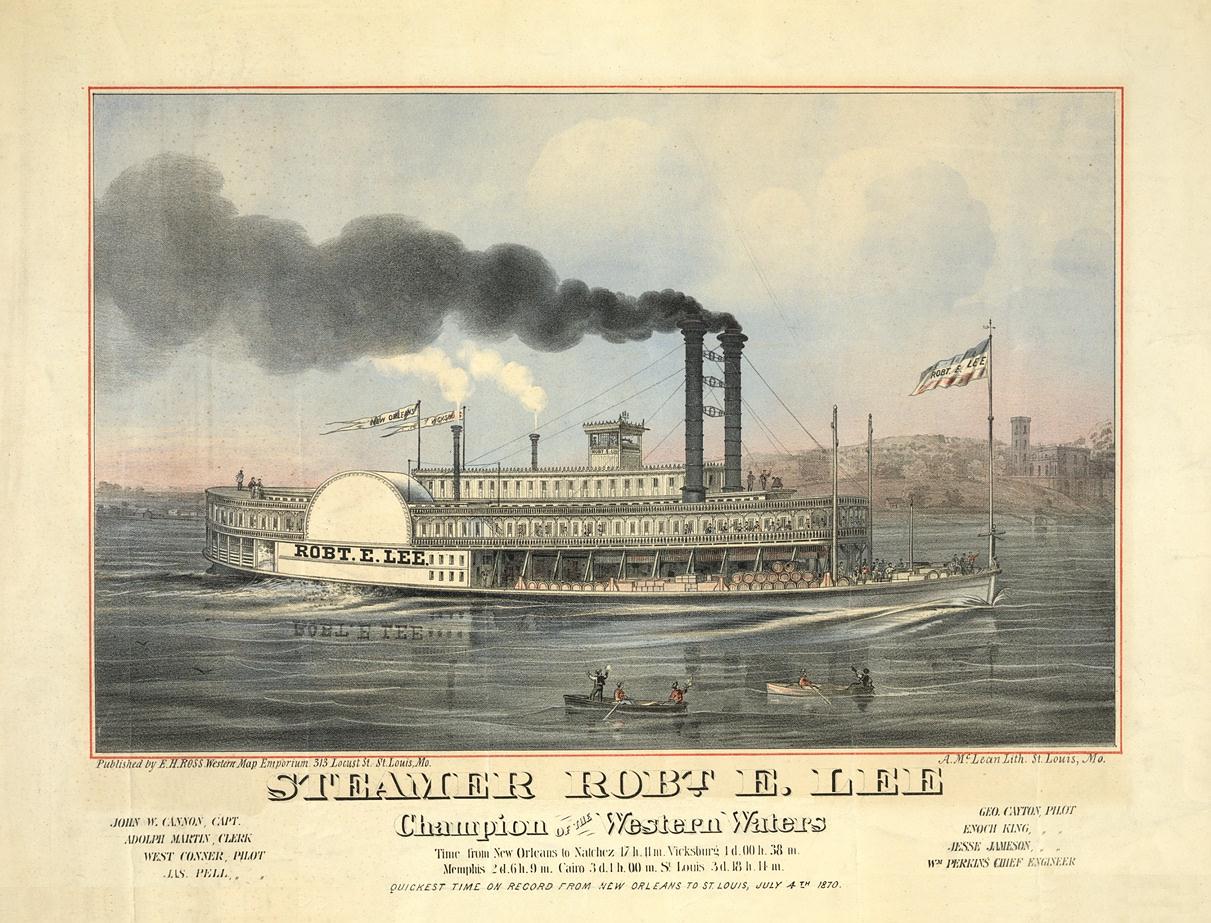
Steamer Robt. E. Lee. Champion of the western waters [1870]
Published by E.H. Ross.
Western Map Emporium
313 Locust Street
St. Louis, MO
A. McLean Lithographer
St. Louis, MO
Reproduction Number: LC-DIG-pga-03963
(digital file from original print)
Library of Congress
Prints and Photographs Division
Washington, D.C. 20540
Collections: Popular Graphic Arts
loc.gov
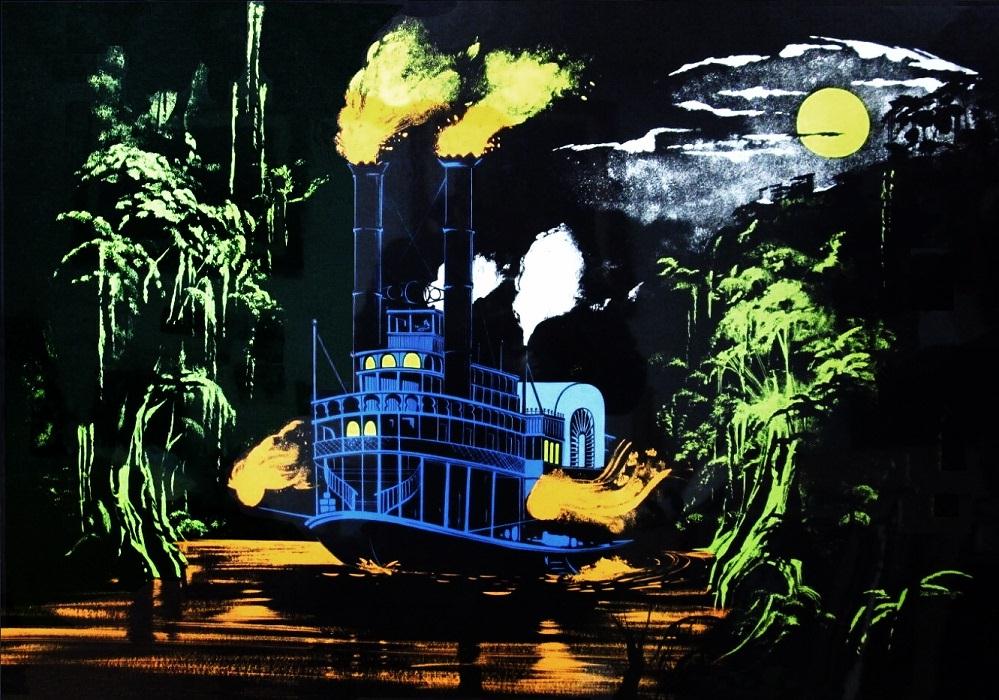
Fixed the smokestacks: 1971 Black light poster of BAYOU BY TORCHLIGHT (based on Currier & Ives)
Listed by vintageposterworld on eBay is this 1971 Blacklight poster 24 1/4 X 34 3/4 inches based on the Currier & Ives color lithograph called BAYOU BY TORCHLIGHT. This would have been printed or silk screened with fluorescent colors on a black background and with the aid of a "blacklight" (Ultraviolet lamp) in a darkened room, the foliage, steamboat, fire, steam reflection and moon would appear to be intensely luminous and even glow in the dark.
The following is composed of excerpts from a book review by Oliver Ho 29 October 2009 in POP MATTERS
"Ultraviolet: 69 Blacklight Posters From the Aquarian Age and Beyond" by Dan Donahue
popmatters.com
Published by Abrams Image
80 pages
Published 2009-2010
The far-out heart of Ultraviolet lies in its posters: R. Crumb's famous Keep on Truckin' and Stoned Again, Stanislaw Zagorski's mind-bending Fly Carefully, George F. Goode's Jungle Princess, and Tom Gatz' Acid Queen, among many others.
The book features 69 posters, all produced between 1967 and 1972 (apparently--a few don't have years attributed to them), and covering a wide range of subjects, all of them groovy. Every page evokes nostalgia, perhaps a flashback, and conveys a strong sense of the wild power and energy of the times.
Counterculture historian Dan Donahue compiled the book, and contributed a lucid and thorough essay that covers the development of the oddball art form associated most often with the late '60s, when "the blacklight poster had become the premier freak flag to hang at the door to a new consciousness." In his history of the "blacklight revolution," the use of ultraviolet light originates (possibly) with secret communication techniques used in WWI, and flourishes with the spirit of experimentation and hallucination in the Summer of Love:
"The blacklight poster was actually a medium capable of mimicking the effects of the new wonder drug. With the ability to glow and vibrate under ultraviolet light, the posters could simulate the sensations and visual distortions one experienced during an acid trip."
The combination of strange technology and altered states (as well as the subject matter of many of the posters) makes the blacklight poster seem to be a key contributing element of the "hybrid" art form described by Christoph Grunenberg in his forward to Summer of Love: Art of the Psychedelic Era:
"The psychedelic era was the result of a highly productive interaction between art, technology, politics, drug culture, music and many other influences, creating an extraordinary aesthetic exemplifying the spirit of liberation and freedom...The fusion of different artistic techniques in producing all-encompassing sensory spectacles was central to the new movement, culminating in a new hybrid art form variously labelled 'intermedia', 'multimedia' or 'mixed media' art."
Possibly the first book of its kind, Ultraviolet embodies Grunenberg's stated desire to "move beyond a purely nostalgic reception and attempt to understand the original creative and visionary potential of the period." Indeed, one of the most fascinating aspects of Donahue's essay is his introduction of many key artists in the medium (not all of whom are represented in the posters, unfortunately), and his deft descriptions of their styles, influences, techniques and notable works. Donahue manages to balance historical details with colorful character biographies and trippy turns of phrase.
"The blacklight version of turning on is flipping the electric switch and waiting for the unmistakable hazy glow...Used in combination with outrageous illustrations, the light created a glorious glow and spectacular optical odysseys."
Then there was Grunenberg's essay in Summer of Love, on "LSD Art", where he writes:
"At best, psychedelic art...evokes the effects of perceptual distortions on perceived or imagined objects, rendering multi-coloured forms and excessive, repetitive patterns, in a state of constant flux."
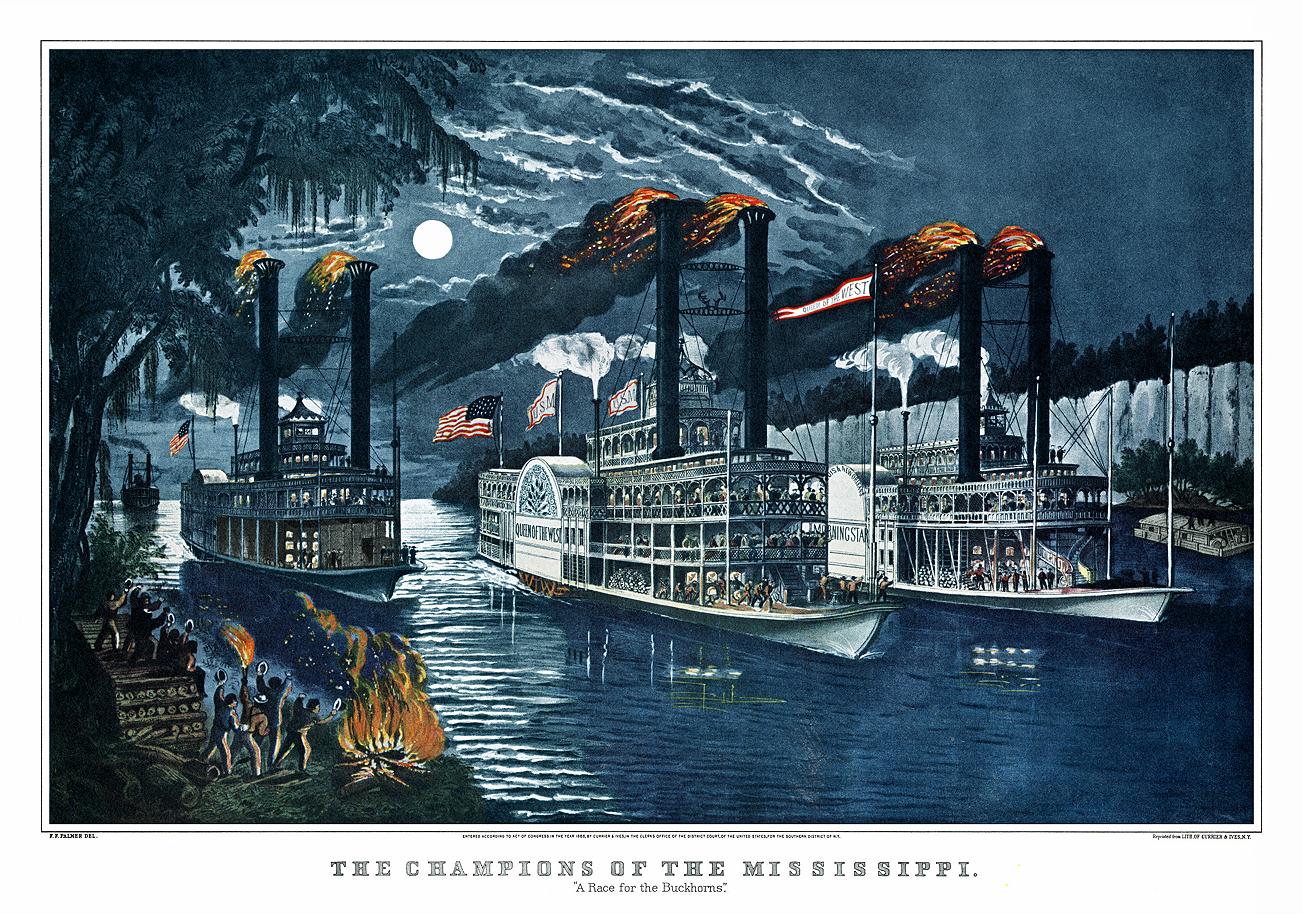
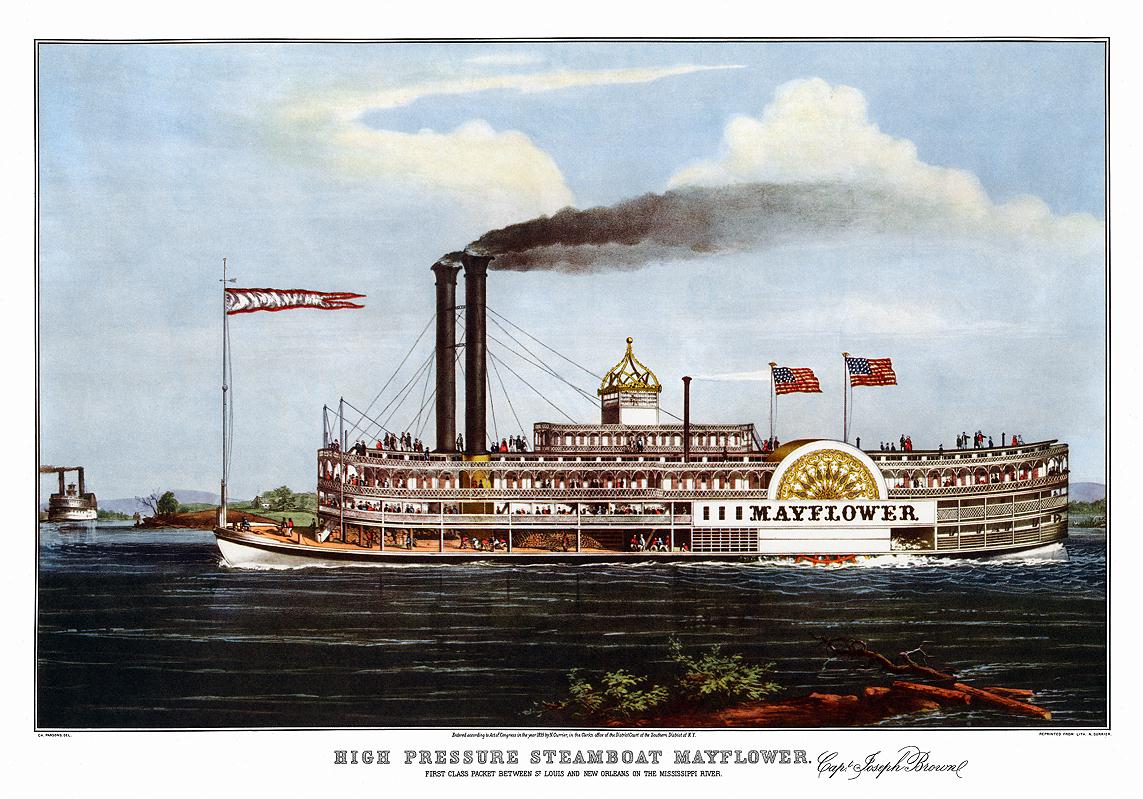
A Currier & Ives beauty from 1855, the MAYFLOWER from St. Louis to New Orleans under Captain Joseph Brown. Nice image of a "double decker." Scanned this off a 1950's calendar and by taking the yellow out of the color lithograph and the margins it looks like it's been freshly printed.
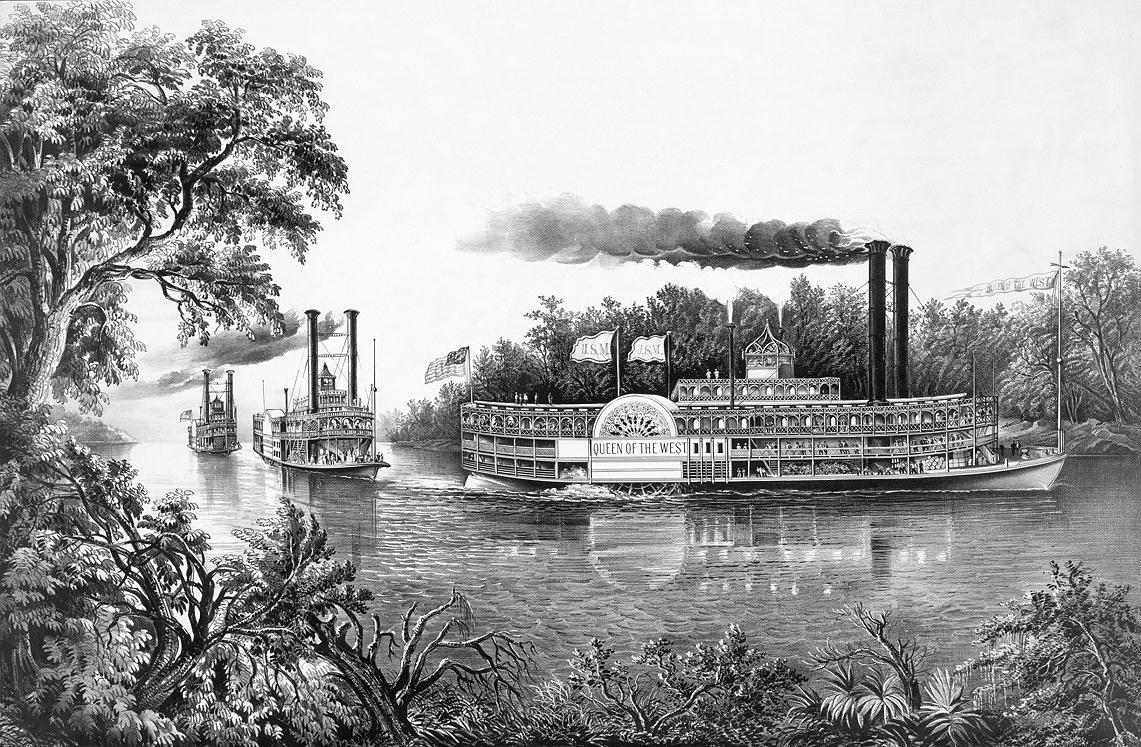
Another Fanny Palmer triumph in the same style as her "Champions" sent previously, also from the Library of Congress. Rounding a Bend and the Champions were both transformed into night time scenes in the Currier & Ives color prints. A sky rocket was being fired off the top deck at the stern of the Queen of the West that described an arc into the sky which was very effective in the night time version but didn't make much sense in the black and white rendering so it is absent here.
"Rounding a bend" on the Mississippi: the parting salute
(The Queen of the West in starboard profile)
Lithograph published by Currier & Ives, circa 1866.
Below is the color version with the sky rocket visible.
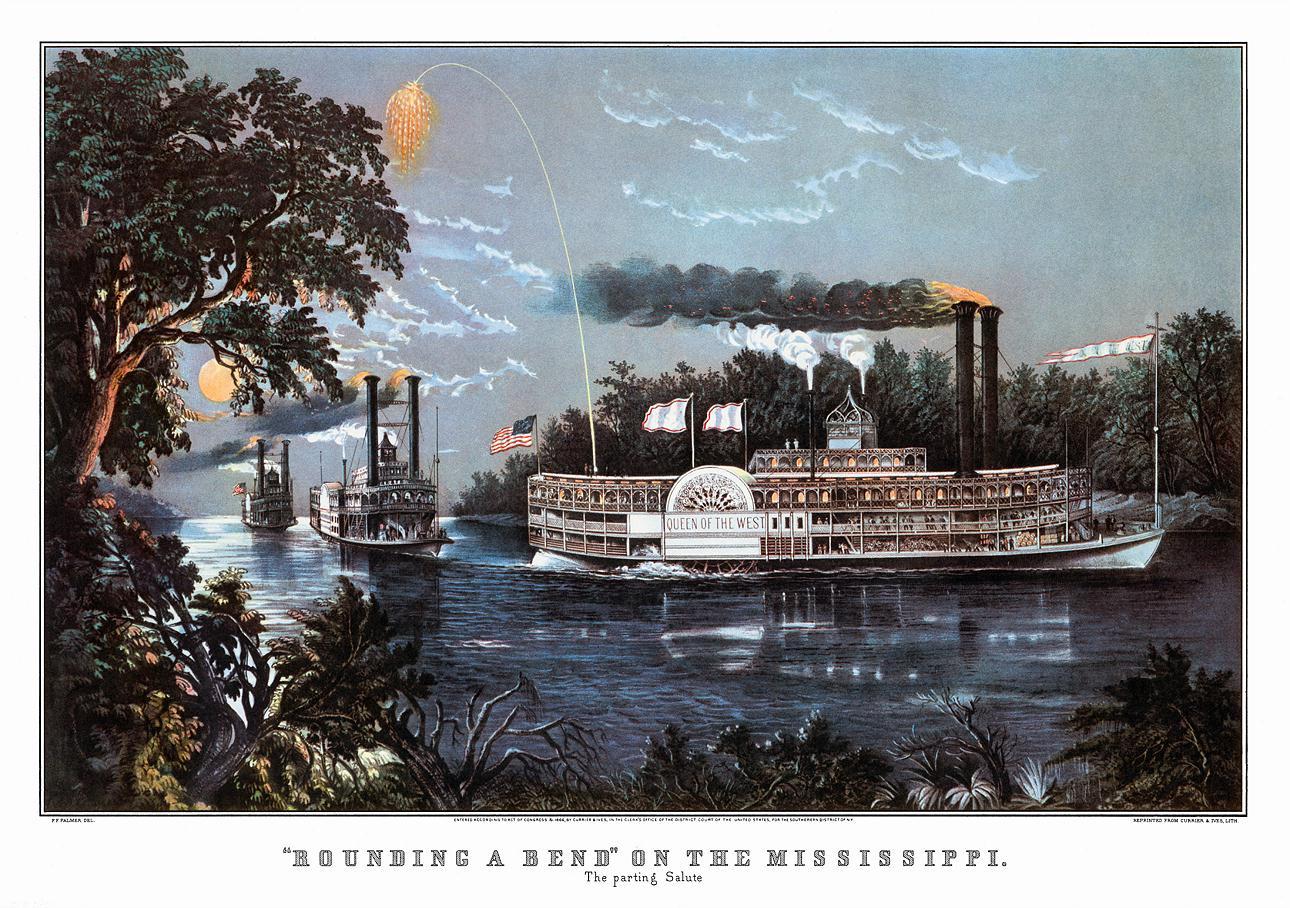
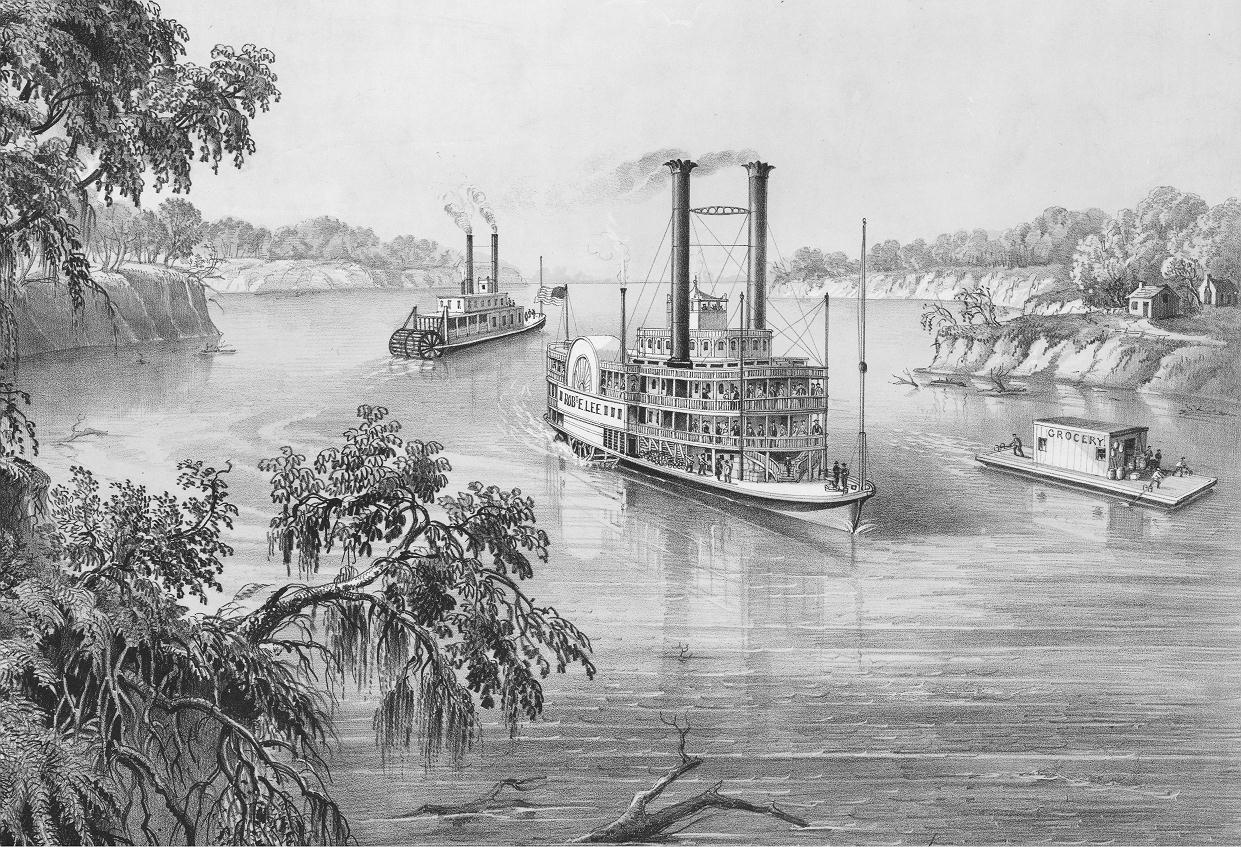
Third graphic that Fanny Palmer rendered for Currier & Ives. This is a detail of the steamboats on the river. On the bluff and in the foreground a cabin, there originally were freed slaves dancing happily. Palmer's strength lay in landscapes and steamboats but her stylized African Americans are uncomfortably grotesque and this version without them is much better - focused on the subjects we're interested in.
Low water in the Mississippi Published by Currier & Ives, circa 1867
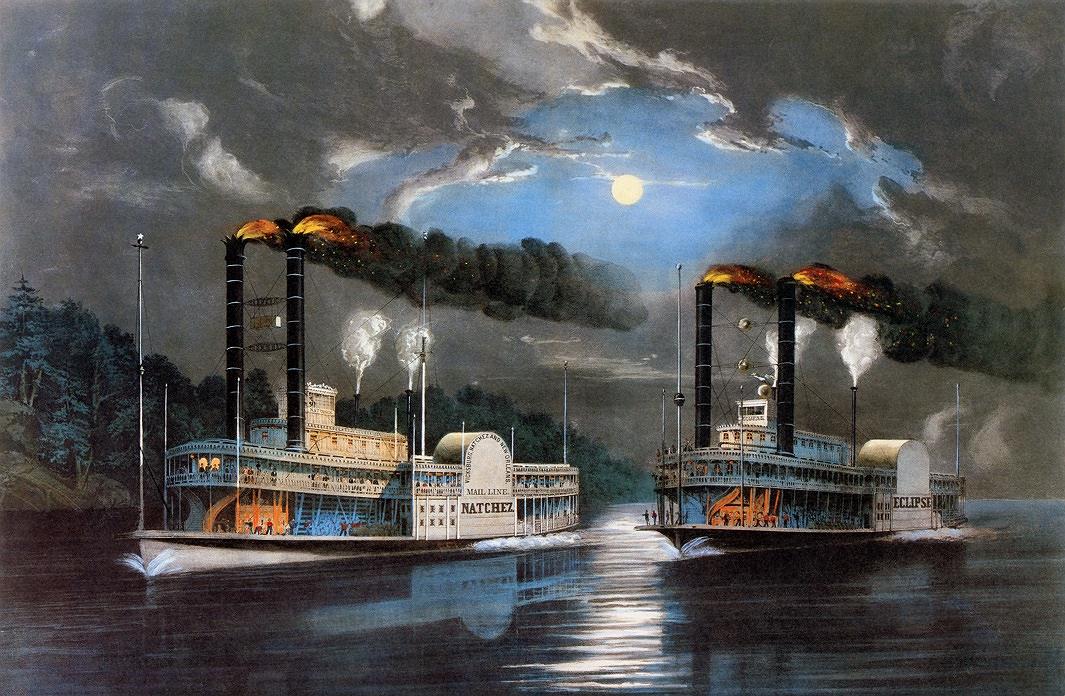
Currier & Ives - A Midnight Race on the Mississippi, 1860
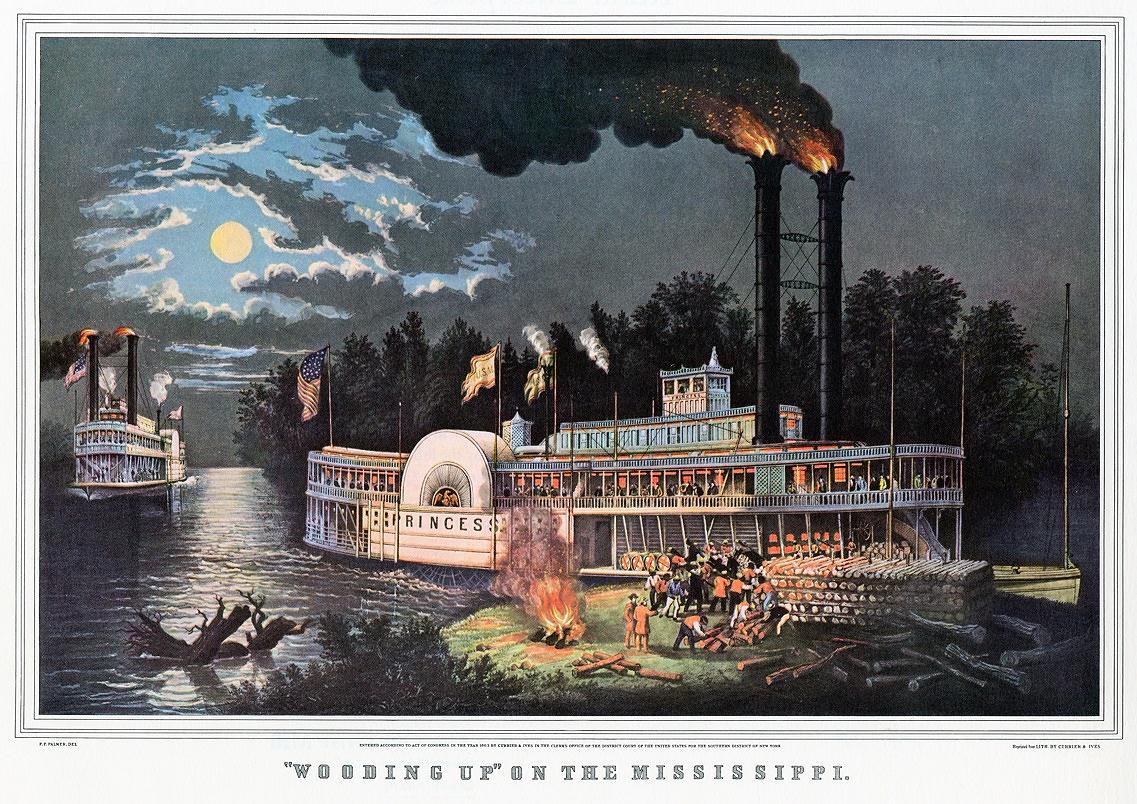
Currier & Ives - "Wooding up" on the Mississippi 1860
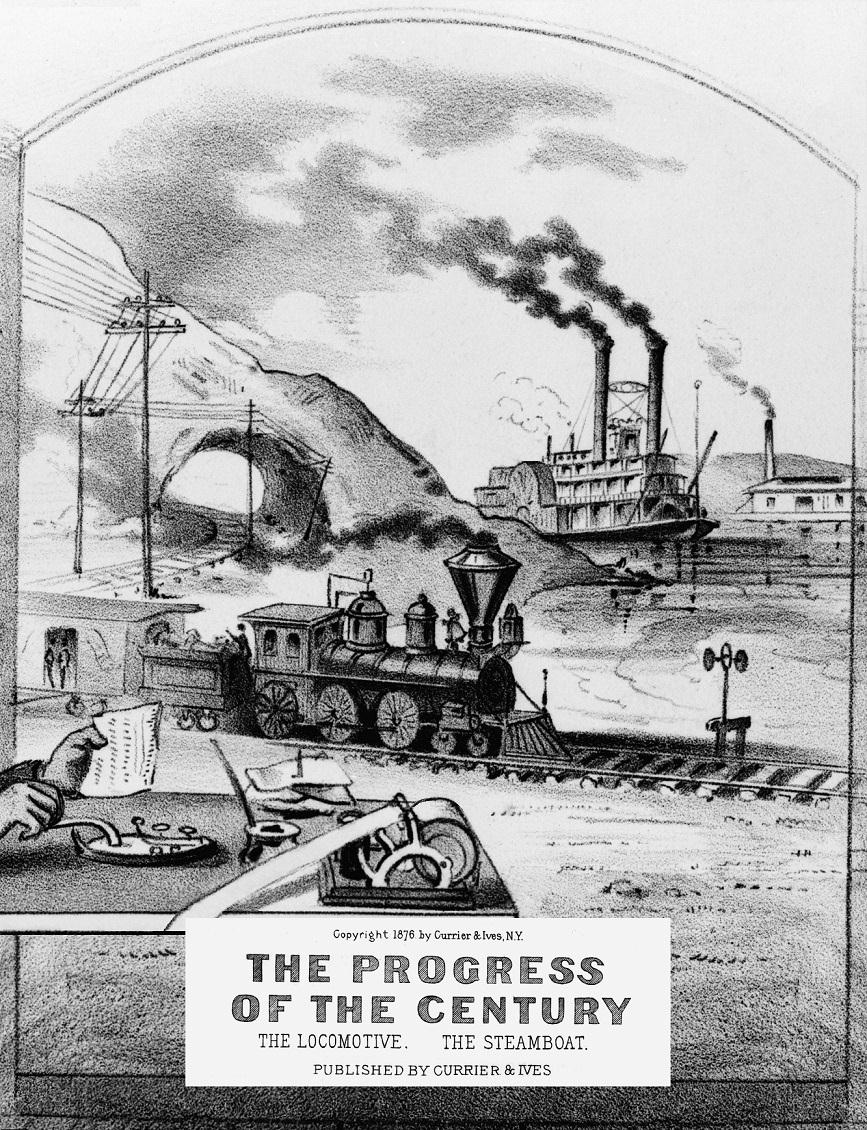
1876 Currier & Ives Steamboat and locomotive (2 of the milestones in the progress of America's first 100 years)
Detail from upper right corner of a Currier & Ives lithograph THE PROGRESS of the CENTURY 1776 - 1876
"The progress of the century - the lightning steam press, the electric telegraph, the locomotive, [and] the steamboat"
New York: Published by Currier & Ives, 1876.
10 1/2 x 13 inches
Man using telegraph in foreground; in background use of steam press, steamboat, and locomotive.
Library of Congress
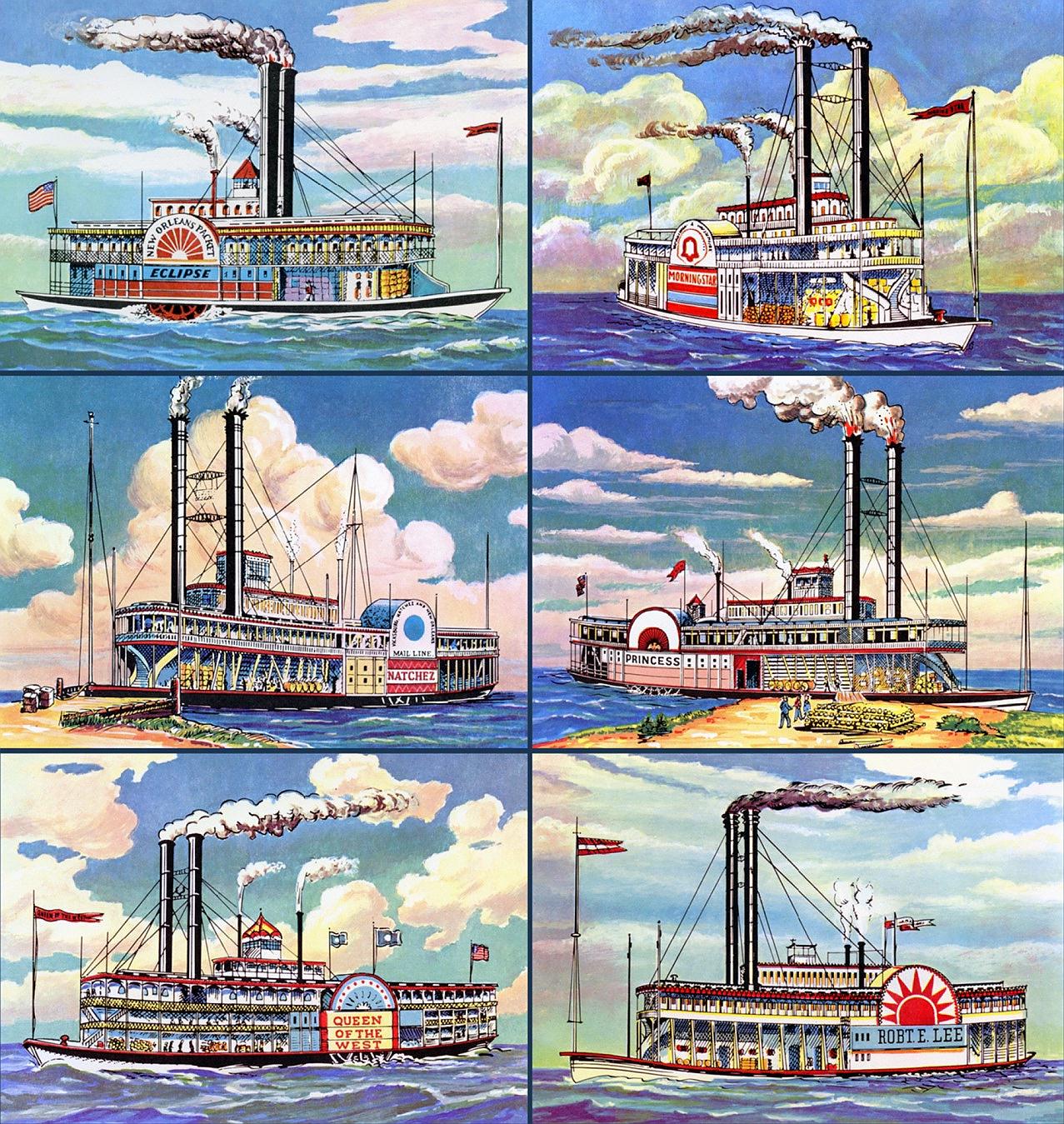
Steamboat prints based on Currier & Ives lithographs
Copyright Diamond National Corporation
Diamond Match Division, New York, NY.
Set of 6 steamboats drawn in pen and ink and color added with translucent and opaque paint. Each based on boats that were featured in Currier & Ives prints circa 1850s & 60's. Artist was not credited. Possibly date from the 1950's. Probably obtained by originally by consumers who sent in "proof of purchase" from boxes of Diamond matches.
Each graphic is printed separately on white paper with the pictorial area measuring 4.60 x 6.55 inches plus .65 inch white margins around each. Very likely ended up matted and framed in a child's nursery at home.
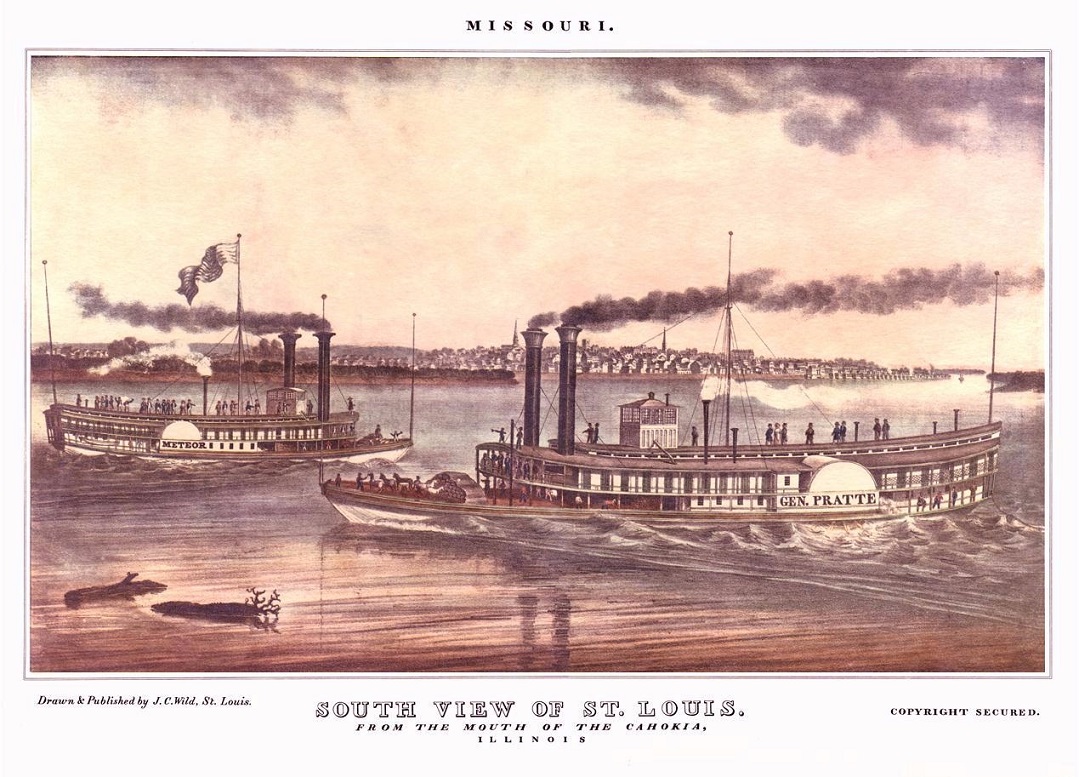
Mississippi Lime Co. of Alton, Illinois 1970 reprint of J.C. Wild's SOUTH VIEW OF ST. LOUIS, 1840.
Some of these early boats had what amounted to a ship's mast amidships, mostly to fly huge flags from apparently and there may have been a crow's nest as well where someone used to smoking tobacco might have some tolerance for black sooty smoke from the stacks when the wind blew it aft.
The brace attached to the pilot house and anchored on the hurricane deck is a feature which I've seen in other graphics of boats from this era including one of the MISSOURI from 1850. The later system of tying them down with guy wires may have been a little more effective in gale force winds.
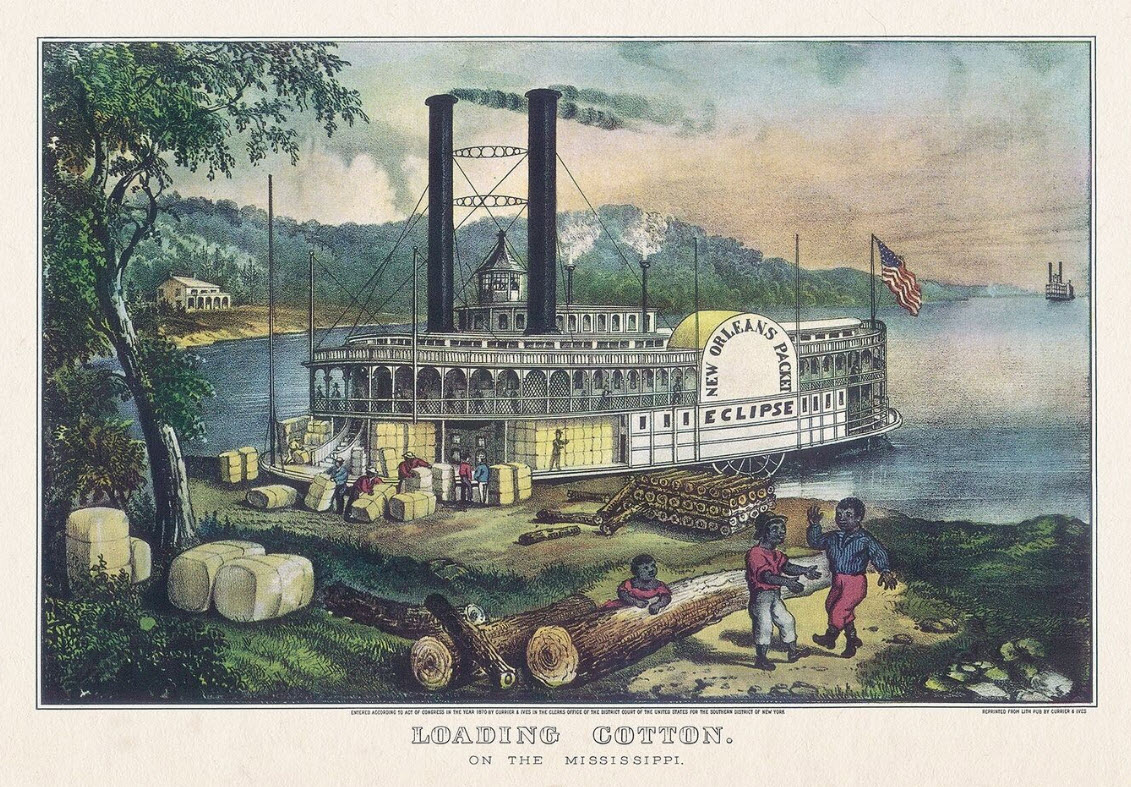
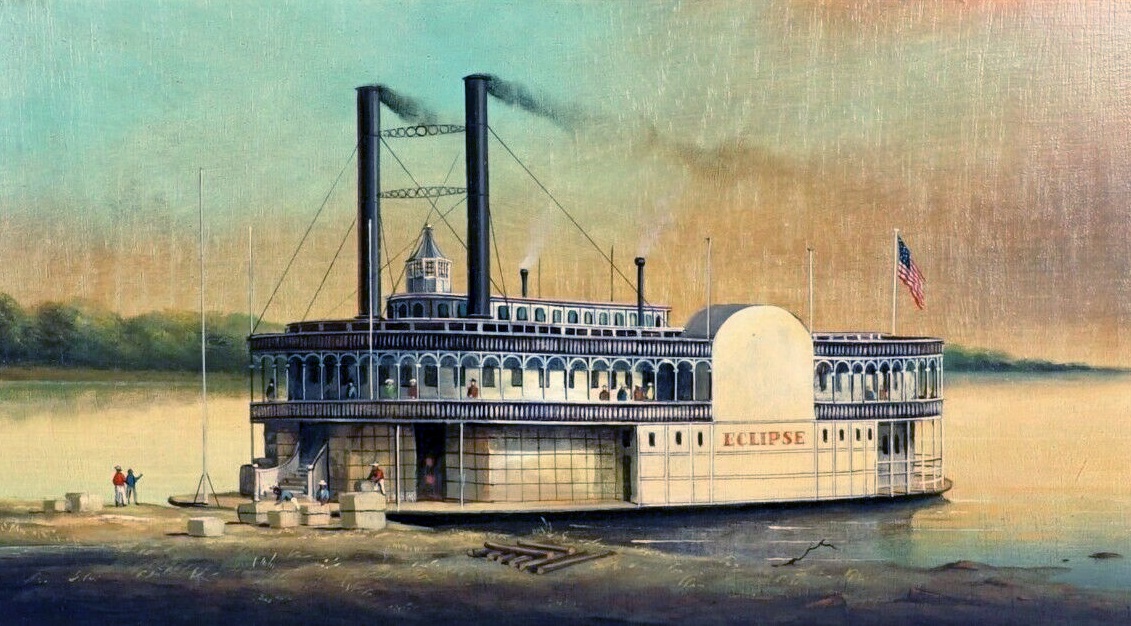
Currier & Ives lithograph LOADING COTTON and Painting By Brian Coole derived from the same steamboat ECLIPSE
Sidewheel Mississippi River Steamboat Eclipse Painting By Brian Coole
eBay item number:
174055870773
eBay
$4,250.00 or best offer
Rare Subject Matter of Artist
COOLE, Brian, (English artist) Sidewheel steamboat ECLIPSE on the Mississippi River
Oil/Wood Panel, signed lower right, 11.78" x 30", framed 17.5" x 35.5".
Born in Edgeware, Middlesex, England, February 14th 1939. Irish parentage, strongest affiliation USA. Still living.
Entirely self-taught. Visits to public museums and galleries give his claimed influences of William Wyllie through a spectrum ranging from Rembrandt to Canaletto, although in the US, his work is compared to that of Fitz Hugh Lane.
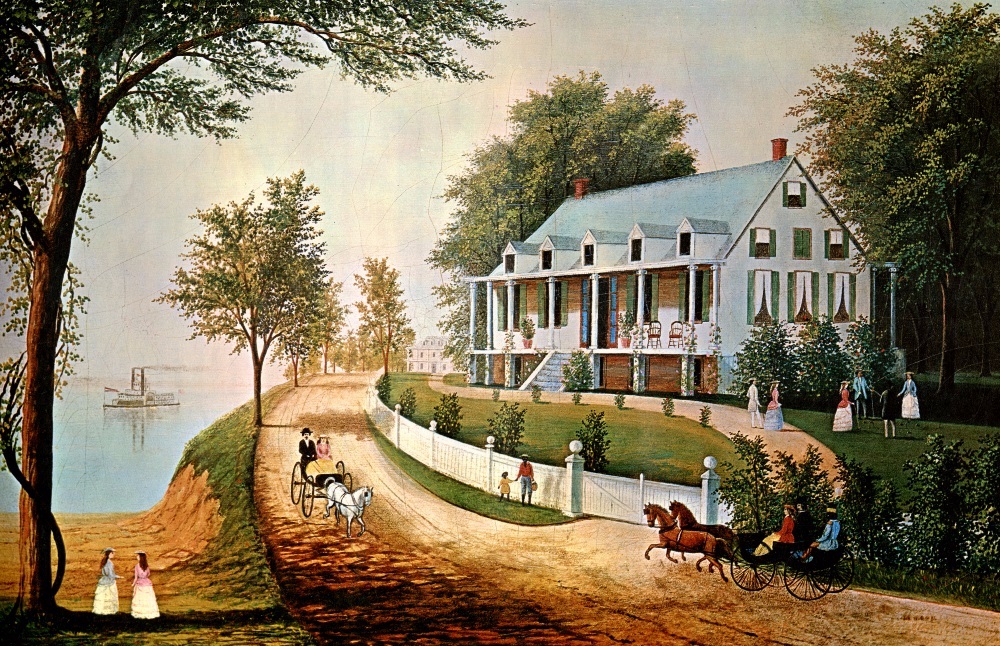
Here is the original painting circa 1865 which inspired the Currier & Ives print "HOME ON THE MISSISSIPPI RIVER" so you can put this first above the other files I sent of the grayscale Currier & Ives and Southern Comfort promotional stuff on a C&I page.
The sidewheel steamboat out on the river far left is tiny but well done and accurate. The house on the right may have actually existed in Louisiana or Mississippi. The artist who reinterpreted this improved on it quite a bit in terms the architecture.
One of the big houses on Orchard Point in Hannibal, MO looks like it may have been based on this. The view of the river from the mansions on the Point is breathtaking.
Below is the descriptive text on the back of the print which credited the New Yorkers who owned the original painting.
Respectfully your humble servant,
G. David the Second
ANONYMOUS
HOME ON THE MISSISSIPPI RIVER
Collection of Edgar William and Bernice Chrysler Garbisch, New York
"[We] all miss the Eden from which the passing years and the Tree of Knowledge have banished us all. If a picture can make us dream that we have won back that innocence, we respond with happy gratitude." So writes James Thomas Flexner in his book on American art, That Wilder Image. It is indeed an Eden of the Deep South that we see here, a peaceful, dreamy, warm way of life beside slow-moving waters.
Home on the Mississippi River may already have been a dream by the year 1865, when this picture was probably painted, for artisan-artists often painted not what they saw but what they remembered. We cannot be sure of this, however, for there were some corners of the South untouched by the destruction of the Civil War. Whether dream or reality, the work presents a series of sweeping curves to draw the eye from back to front and around to the stately house. Curtains and shades are mathematically drawn and hint at a dark, cool interior with high-ceilinged rooms filled with polished mahogany, crystal chandeliers holding many waxen tapers, soft-spoken, sure-footed servants, and pretty Southern belles in fluffy white dresses. Outside, held back by the levee, is the river down which the bales of cotton sail, and along the road atop this embankment drive sociable families on their way to friendly visits, to play croquet on other well-kept lawns, or to sip a cup of tea or a mint julep. Tears, toil, sweat, and blood are conspicuously absent here. The only signs of a working class to uphold this elaborate structure are a groom sitting stiffly in the rear of the carriage in the foreground and a black field hand holding a small child by the hand outside the wall. We are all, black and white, banished from this Eden now. For some, things are better; for others, much worse; all of us can dream of the past and hope for a better future.
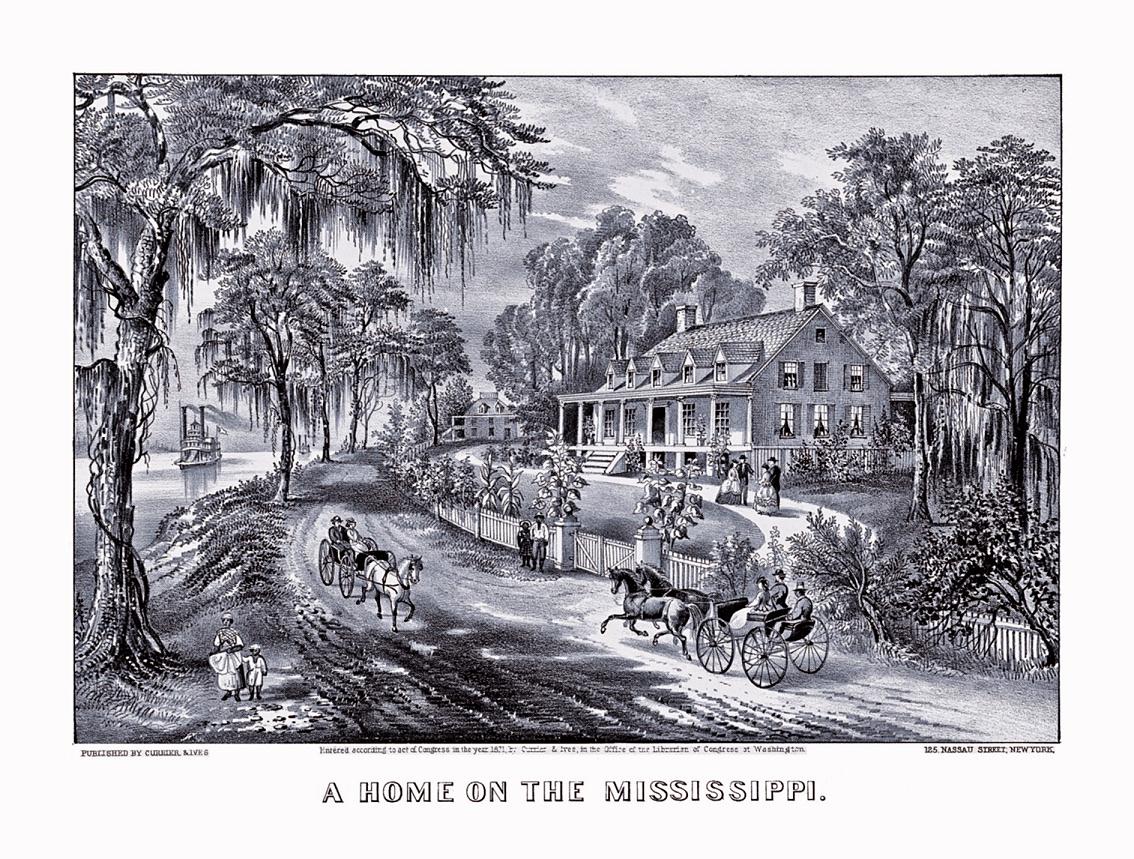
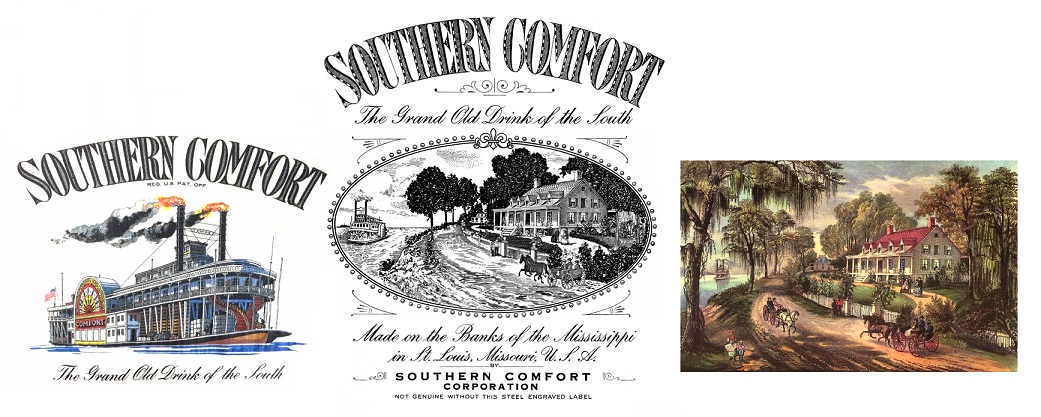
A HOME ON THE MISSISSIPPI
Published by Currier & Ives, 1871
Library of Congress Prints and Photographs Division Washington, D.C. 20540
Reproduction Number: LC-DIG-pga-09099 (digital file from original item) LC-USZ62-12927 (b&w film copy negative)
There is an original painting that this was obviously based on. I have ordered the print twice, first on Etsy which never showed up so I ordered a second on eBay which I will scan and add to this display if and when it arrives. Both prints must both have been removed from an edition of the same book and attributed only to 'anonymous.' In the painting the steamboat on the far left is depicted in a portside profile rather than approaching head on as it is in the Currier & Ives charcoal drawing.
Southern Comfort 'a smooth drinking whiskey' was created in 1874 by M.W. Heron in New Orleans and grabbed the image of A HOME ON THE MISSISSIPPI and put it inside an oval vignette as the centerpiece of their label and Southern Comfort also spun off of the steamboat theme out on the river far left and commissioned commercial artists to represent steamboats in various poses and situations in their promotional material which included advertisements in periodicals and framed presentations made primarily for display in saloons and bars and have become collectable items for 'man caves' today.
Included here is a composite with the Southern Comfort label in the center while on the left, a Southern Comfort promotional T-shirt graphic features the same steamboat that we have in an oval vignette format from a promotional mirror elsewhere in the gallery. The color version of tA HOME ON THE MISSISSIPPI on the right was Currier & Ives own edition with color incorporated over the black and white charcoal drawing featured in the Library of Congress file.
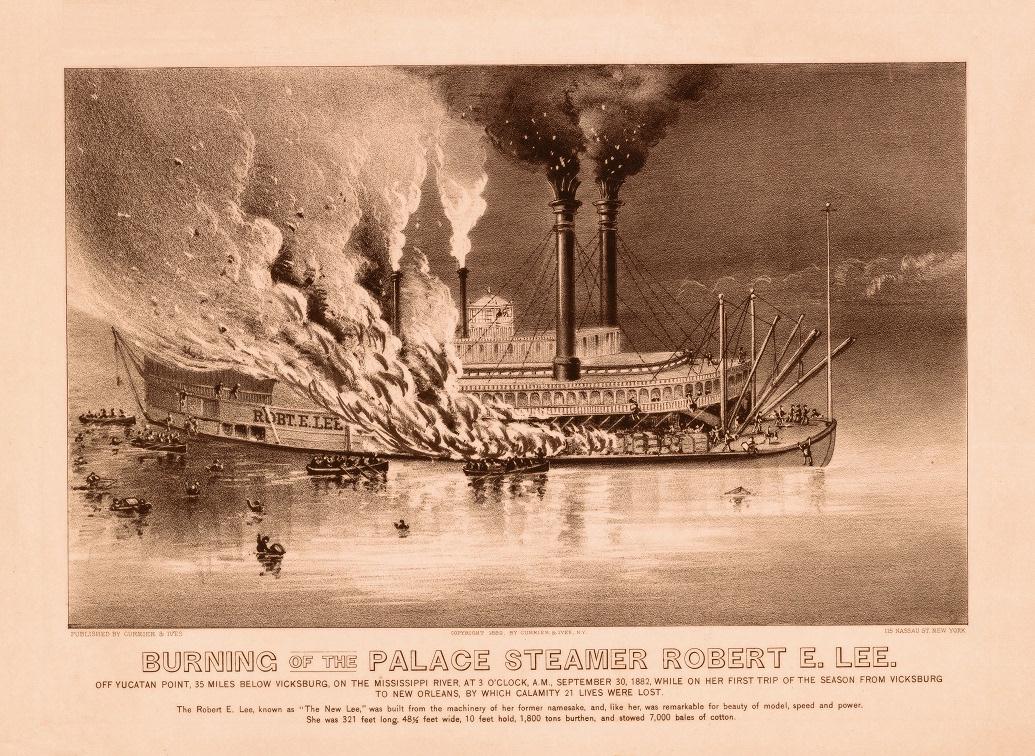
Burning of the Palace Steamer Robert E. Lee: Off Yucatan Point, 35 miles below Vicksburg, on the Mississippi River, at 3 o'Clock, A.M., September 30, 1882, while on her first trip of the season from Vicksburg to New Orleans, by which calamity 21 lives were lost Currier & Ives, 1882
LIBRARY OF CONGRESS Washington D.C.

With the exception of images credited to public institutions,
everything on this page is from a private collection.
Please contact Steamboats.com for permission for commercial use.*
All captions provided by Dave Thomson, Steamboats.com primary contributor and historian.
